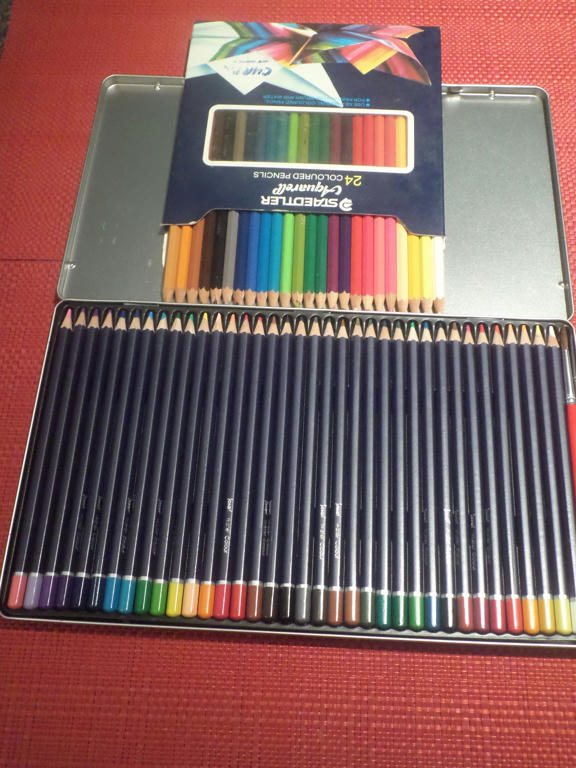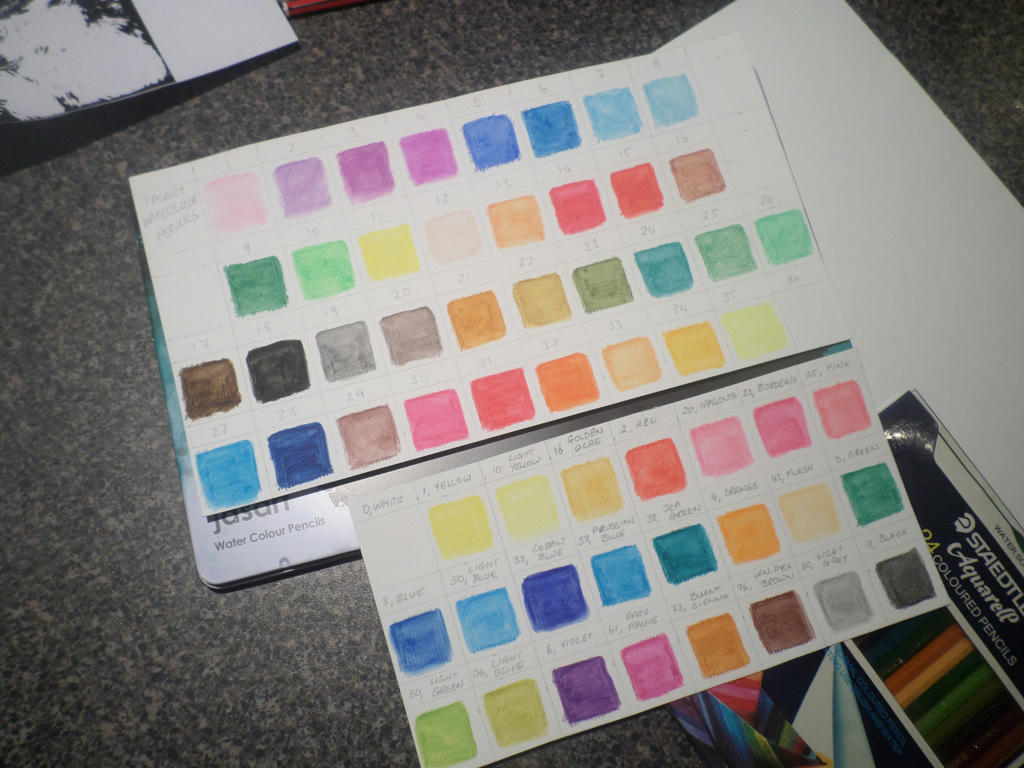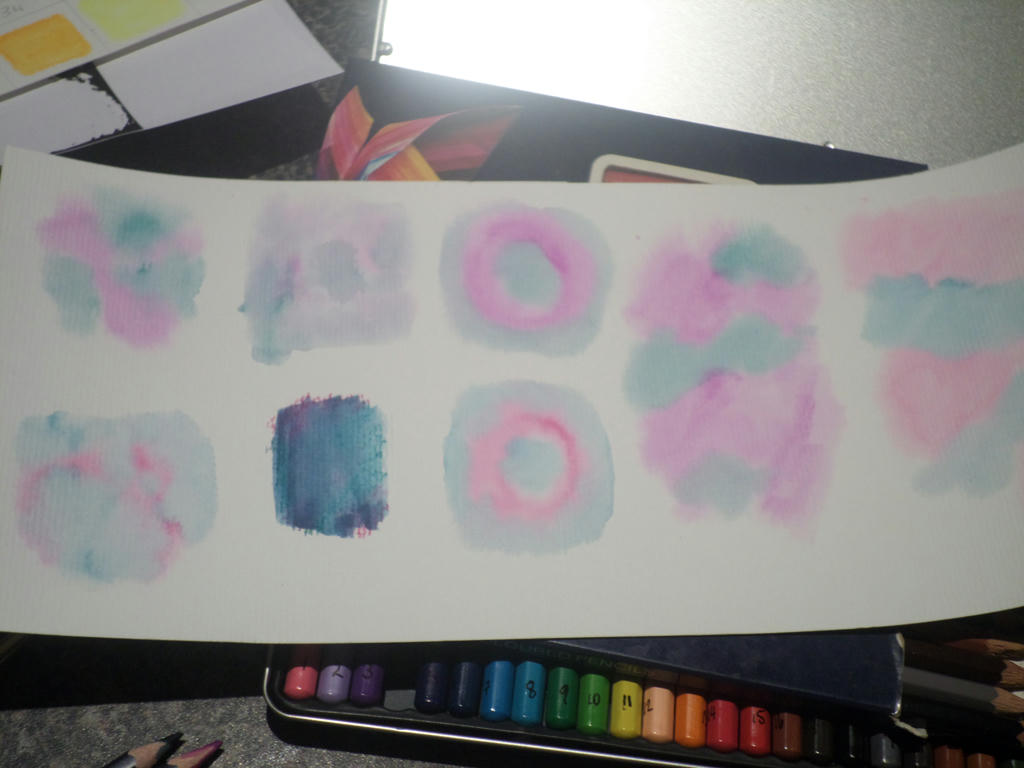Old set (top) new set (bottom)
Unfortunately, when I purchased my new tin of 36 watercolour pencils, I thought they were Derwent (UK made) but it turned out they were Jasart. I must have gotten that confused with the Inktense pencils made by Derwent, which I bought at the same time.
The problem with the Jasart pencils were, they didn't mark their pencils with numbers, or have the corresponding colour names, written on the packaging. Not even the name of the manufacturer was on the tin, or where it was made. So after I numbered the pencils myself, I did a sheet of swatches, to see what I was using.
Jasart pencils (top) Staedtler pencils (bottom)
It's a good idea to do swatches even when you have the colour names (as I had on my Staedlers) because the colours change once water is applied. My squares were only 3cms x 3cms, but were enough to demonstrate each pencil's saturation.
I noticed a few things about the two different sets of pencils though. Even though my existing Staedtler set were aging, when water was applied, they had really creamy texture. The newer Jasart pencils seemed to have less pigment in them, so when water was added, their colour was less intense.
It might also have to do with the fact, the Staedtler pencils were harder to apply dry, so I had to colour harder - therefore applying more pigment. The Jasart's were so much easier to apply dry, I had to barely press down at all. So perhaps that's why I didn't get such a strong pigment when water was added?
darker purple is the new set of pencils
On the bits of watercolour paper I had left over, I conducted a few experiments to see wet on wet application. I wet the paper first, then applied water directly to the pencil with a brush - then applied the brush to paper. It was a very fun experiment and I will have to do more. I tried to get a bloom effect to happen, which I wasn't successful at.
It's important to remember you should never sharpen your pencils after they've been wet in this way though. They must be completely dry before sharpening again, or you can damage the wood.
Speaking of wood, that's another problem with my ageing set of Staedtler pencils. They are almost impossible to sharpen now. The wood has hardened so much, the sharpener eats them up. Big chunks of wood come off. The greener the wood, the easier they are to sharpen.
So bear that in mind when buying watercolour pencils. Try to get as much use out of them as you can, and never use a dull sharpener to sharpen older wood. I recently sharpened the blade on my sharpener, as I have a stone, and yet it still chewed up the old wood. Imagine what a dull blade would have accomplished?




I have the same problem with the wood on my colored pencils-Prismacolors. I have read reviews that have said this is a problem with the company. It looks like you will need to use a blade to sharpen them now.
ReplyDeleteAs to saturation-I think that the issue is the binders used. I don't know what is used in watercolor but I do know pastels use a glue of some kind while colored pencils can use wax. So you probably have two different saturations because of the binder or the binder/pigment ratio.
I think these charts are nice to make-as you said, on paper the color can look different. I like your experiments too.
I've considered using a blade to sharpen and it may reduce the chewing a traditional pencil sharpener does. But the wood is really fibrous. I'm still going to try it though.
ReplyDeleteI'm really grateful for the chart as it helped me complete the recent self-portrait. It's much easier to compare what colours will work together when they're pre-saturated, because they look so different raw.
It is great to have that information handy. How do you mix color with these pencils? On the work itself I suppose but do you wait till things dry then layer colors or do you apply it all at once and then wet it?
DeleteGoodness, I've just realised I haven't replied to this post yet. Sorry.
DeleteI try to mix on the paper, by laying down different colours. I start with the main observable colours, leaving white areas for highlights and then add shading colours. By overlapping, the blending is better too.
I used to apply it all at once and add the water for blending, but have since learned if you start with the basic colours, highlights and shades, you can add more as you feel it needs. Because its hard to judge what you're going to get if you try and apply it all at once. Best to start with the minimal approach and add more layers, than waste all that material to make something which doesn't ultimately work.
I've seen tutorials for both methods - all at once or start basic and add as you go. It seems experimentation sorts out what style suits you. :)
I actually tried to work with the set of pencils I have yesterday. I didn't find that the colors mixed all that well but it could be that I have a learning curve there. I also used my cheap 90 lb paper which is much more textured and I think that can be an issue with mixing pencils-the pigments gets caught in the cracks requiring more water which might be why you are not getting the results you hope to get with pencils. I confess to disliking them now. I see the point of using them but for the kind of work I want to produce its not going to ever be a main tool for me. I can see using them for finer details that a brush might not be able to handle in a my beginners grasp though. You are brave to want to master them.
DeleteI think you're right about the paper being the problem. I had been wondering about that myself, as I have a very rough textured paper. Yesterday I uncovered a stash of watercolour paper my mum gave me years ago. It seems to be a lot smoother. It will probably work with the paints and pencils much better.
ReplyDeletePencils are certainly harder to mix on the paper with water, than the paints. You have to work the brush more. I find its best to start in the lighter areas and work towards the dark, because that's where a lot of the pigment will end up. If you do it the other way around, you'll end up with your lighter areas, darker than you want them.
If I had started with watercolour paints I think I wouldn't have liked the pencils either. They seem like a lot of effort in comparison. The paints go on so much quicker. But since I've worked with the pencils for so long, I guess I have a soft-spot for wanting to improve my skills with them more.